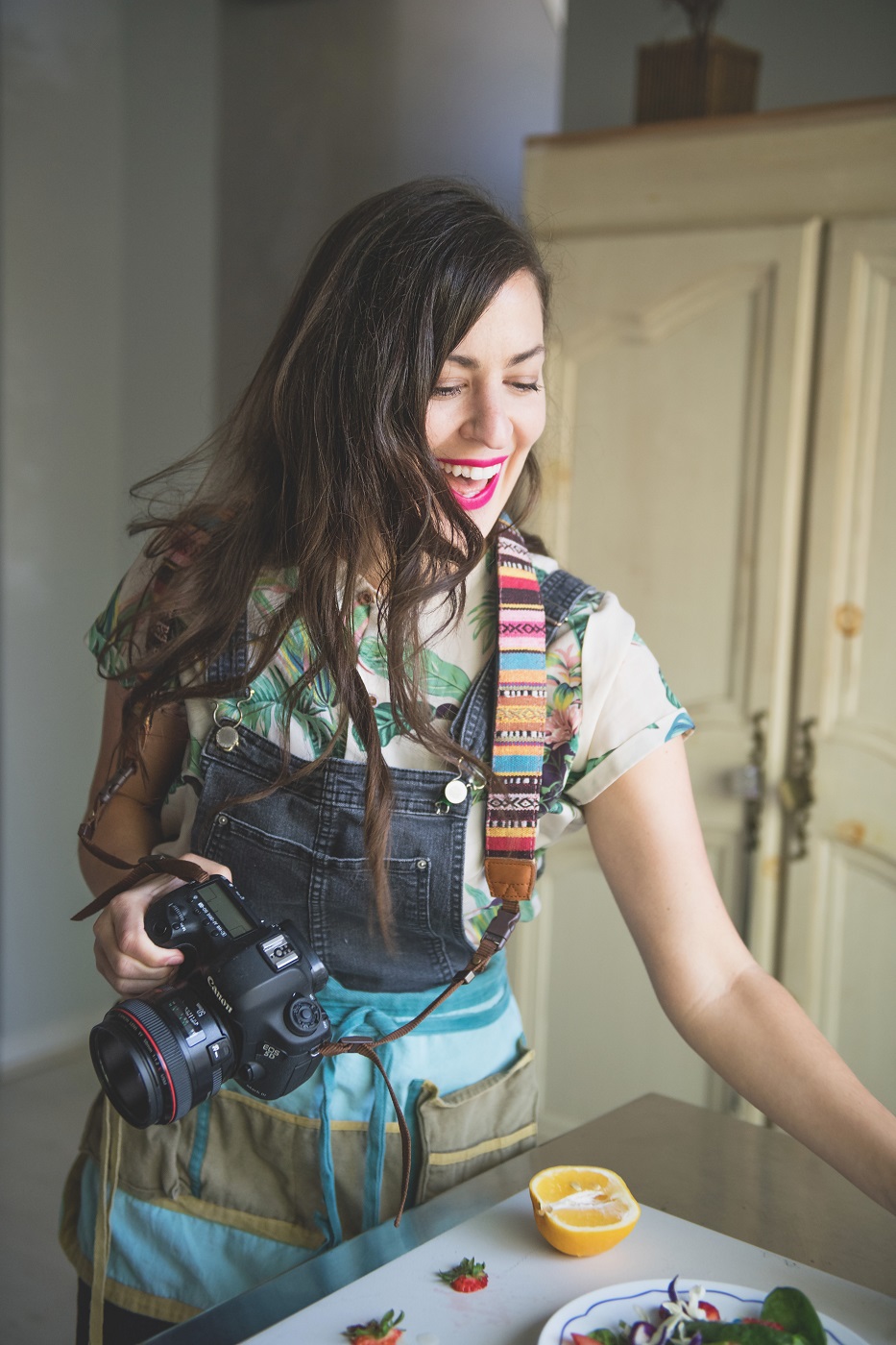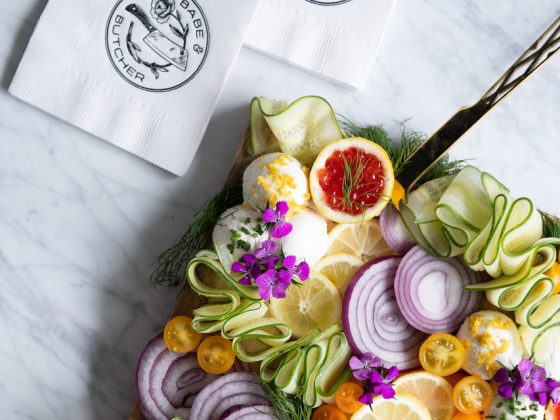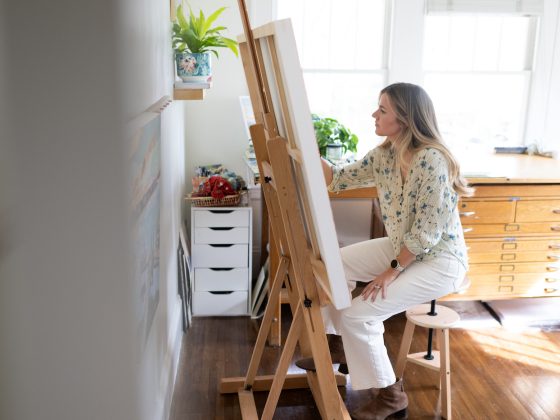Anna Naphtali has that thing where it just seems there’s no way she could have lived a life as anything other than an artist. I know that may sound reductive, or like I’m pigeonholing her, but I’m telling you: From her innate skill sets to her tangible childhood memories to simple things like how items are styled in her home, you can tell Anna has an eye that allows her to see things just a little differently.
Anna is, by trade, a photographer, food stylist, creative director, and, really, something of a visionary. She’s worked for everyone from Carrie Underwood to Kinfolk Magazine and Architectural Digest to ABC’s Dancing With The Stars, and she teaches classes at creative conferences across the country. But don’t be mistaken: Anna is not a dabbler. Rather, she’s an experience-seeker, a submerser, the type of person who has stories like, “that time I joined a breakdancing crew in Monterrey, Mexico,” or a nine year period in which she was part of a hip-hop/jazz fusion band.
To give more context, though she was born in Uptown Charlotte, Anna moved to Australia at age 18, spent three months in the jungles of Malaysia, two in London, studied Spanish and Breakdancing in Mexico, and then returned home in her mid-twenties. She has done stints in various places since, while working as a production assistant, freelancing for NBC, working in online content creation… but with all that change, never did she put down her camera.

Eventually, as a passion for photography flourished alongside what is a deeply ingrained connection to gourmet food culture, Anna Naphtali went back to school to complete programs of Design and French Food Culture at Parsons in Paris and to study Mediterranean Culture and Food Systems Design in Barcelona.
Her images are arresting, beautifully-composed and artfully styled. What you might call her aesthetic is less something you’ll see picked up in an every image, and more the eye she possesses that pervades every shot she has captured and brought to life. When it comes to her work, that’s really a story that deserves to be told in Anna’s own words.
How and when did you first learn photography?
I received a film camera around the age of fifteen, and it was like the world around me came alive. I photographed everything, and felt like I was exploding with creativity.
The South is a major influence for your life’s work, you’ve said. How, and what made you return here for good?
I grew up in my grandmother’s kitchen, and most childhood Sundays were spent getting dirty in the woods, and picking pecans for pie and fresh mint for sweet tea. I think we’re all looking for “home,” and trying to find our way back to the tables of safety, belonging, and the first tastes of feeling loved, whatever that looked like. The hospitality rooted in Southern culture, that I learned from my grandparents, is the soul of my work. Whether it’s telling visual stories, working with food, or creating events and workshops, it all connects to this background: If hospitality is the foundation of my work, art becomes an invitation to the table in some way. As for settling here, the beautiful thing about the Queen City, is that for me, it is familiar. I can go to other cities and find more people that look like me, I can go to Los Angeles and join the hustle for creative jobs or I can rent a flat in Europe, but no matter how long I’m gone, eventually I crave coming back. There’s ocean a few hours one direction, mountains an hour or two the other, and fried okra and BBQ every stop in between. I mean, it doesn’t get much better than that.

Did you always intend to have your own business?
I started a roadside business selling paper bows constructed from notebook paper and tape, around seven years old. Even though I only sold one, half price for a nickel, my entrepreneurial spirit was sparked. My question has never been if I would own a business, it’s always been: what will it be, or what should I pursue?
What do you shoot with today?
A Canon 5d Mark iii, L series prime lenses.
What drew you to shooting and styling food specifically?
I remember sitting on the counter in my grandmother’s kitchen, watching her cook for a group of people. One of the men wandered in the kitchen and asked what I wanted to be when I grew up. My grandmother was plating the food, and I had an insatiable urge to pile the salad and drizzle the sauce, so I looked up and said, “I want to be the person who puts food on the plate.” He said, “oh you want to be a cook, or a chef?” and I said, “no, I want to be the person who puts food on the plate.” I remember he laughed and said, “I don’t think that’s a job.” That desire never went away. It was only natural for me to eventually find my way back into the kitchen with my camera… and then when I began styling professionally, I smile back at that little girl and say to myself, “turns out, putting things on a plate is a job.”
What draws you to that side [styling] of photography versus, say, something that is more photojournalistic in style?
There seems to be an idea that there are more pure forms of photography based on the level of intervention (styling) or not, but even photojournalists can change the way a narrative is perceived by how they crop and angle a subject. I had been photographing for years, but felt like something was missing in my work. I didn’t want to just capture scenes, I wanted to intentionally create and be more involved in what I was making. I think in my hybrid creative state, my deepest interest or skill is in composition and design. I feel connected to food but I see in design; shapes, colors, patterns, lines and the communion of objects in space. Styling can be intuitive, but sometimes I conceptualize months ahead, shop for props, curate scenes to compliment the dishes and then keeping the ingredients looking right with acids and oils, and accounting for the changing of food as it sits out… it has to be thought out. I think providing beautiful images isn’t just about aesthetics, it’s finishing the thought of food, and representing the story with care.

Why did you also start teaching your craft to others?
There’s something so rewarding about connecting with people in person… Something happens when a group of people come together with the openness to create and learn; a collaborative and inspiring spirit ignites. Some of my most altering career shifts and personal inspired moments happen from these environments. I want to love through hospitality, and I want to set people free to dream and create. These workshops and events are a chance to do that.
What is a typical work week like for you?
What I love about my work is that it’s always changing. If I’m styling a catalog or big project, it looks like 8-10 hours a day inside a dim warehouse, where I crawl in and out of a hotel bed and consider daylight a luxury. But the more typical work week looks like hustling a little girl out of bed at 6:20 am, coffee shop hopping where I plan, edit, propshop etc… and traveling to various locations for shoots, unless it’s one of my in-house shoots. I also have certain days I work in my home studio, or two other local studios all day, doing in-house production.
What do you think people may not know, or may even misunderstand, about the life of a professional photographer?
The question I get asked most often is, “how do I have your life,” or, “how do I have your job?” And I usually just laugh, because there are a lot of hidden complexities and hardships in the real parts. Several years ago, I was at my lowest, most heartbreaking point. I formerly lived very fragile, sterile, and fearful, but I found a perspective shift that changed my life. There are no magical fixes to difficulties, but I began to approach problems as routes to adventures, and disadvantages as trajectory for new passion. I surely didn’t plan to be a single mother in my 30’s, but I also couldn’t have dreamed up the adventures we continue to have as this tiny duo. There’s no formula for the life you want to live, but you can change your perspective, take practical steps, re-prioritize, and pioneer your own wild path.












